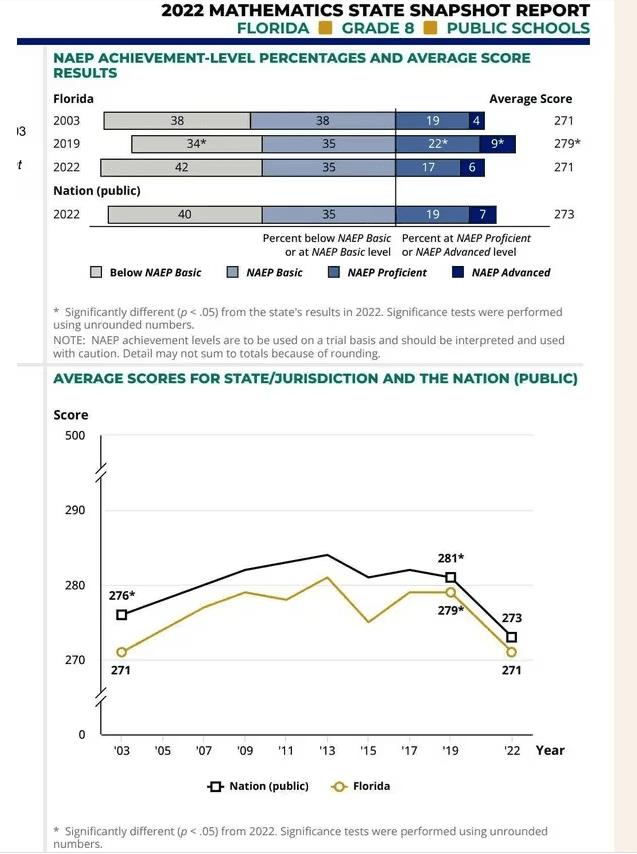
Can DeSantis take credit for Florida’s No. 1 education ranking? Here’s a closer look.
The state’s top rating by U.S. News & World Report is one of the Florida governor’s talking points as he runs for the White House.
Tampa Bay Times | By Marlene Sokol | June 8, 2023
As Gov. Ron DeSantis seeks the Republican nomination for president, one of his key selling points is Florida’s record on education.
“Florida is taking a stand for empowering students, parents and educators to focus on creating opportunities for our younger generations,” the governor said on May 15 at a bill-signing event in Sarasota.
Supporting his case is the state’s No. 1 ranking in education by U.S. News & World Report, released last month and now a talking point on the “DeSantis for President” website.
The publication rated Florida the top state for higher education and 14th-best for grades pre-K-12. Combined, the two components gave Florida the top ranking overall, based on a U.S. News scoring system that considers such factors as graduation rates, test scores, costs and student debt.
How much of that success can be attributed to DeSantis’ policies during his 53 months as governor? It’s a mixed bag.
University tuition, for example, has stayed constant under DeSantis. His office said in a news release last year that he had “held the line” on college costs.
But the trend began in 2013 under then-Gov. Rick Scott, whose push to stop automatic annual tuition increases had helped keep costs down.
On another front, DeSantis and his supporters often credit the state’s push to reopen schools early during the pandemic. They say that by being quicker to recognize the drawbacks in distance learning and the advantages of in-person schooling, Florida gave its students an edge in recovering from learning losses.
But a closer look at the ranking and its methodology shows Florida’s relatively high marks stem partly from actions that predate the pandemic — or even DeSantis as governor. And by key national measures in reading and math, some of the state’s pre-K-12 students are doing better than their peers in the post-COVID era, while some are doing worse.
Affordable colleges, universities
In the case of higher education, a major reason for Florida’s top ranking is affordability, a characteristic of the system for many years.
Florida graduates — including those leaving private schools in the state — owed an average of $24,454, among the lowest in the nation, according to a 2020 report by the Institute for College Access and Success, a nonprofit that promotes affordability. Fewer than half of graduates were in debt, compared with 60% in Delaware and 73% in New Hampshire.
Aided by lower costs, students at Florida’s two-year colleges completed degrees within three years 56% of the time — 20 percentage points higher than the national average.
Average tuition and fees at the state’s 12 public universities have hovered around $200 per credit hour since 2013. That’s in part due to Scott’s push to end automatic increases, which had previously been in place to keep up with inflation. It’s a fact that even DeSantis has acknowledged.
“Florida has ranked No. 1 in higher education for seven years in a row,” he told the audience in Sarasota last month.
Overall, the numbers show Florida as a place of almost unrivaled opportunity in post-secondary education.
The seeds for this success go back even further, said Bill Montford, a former Democratic state senator and now chief executive of the Florida Association of District School Superintendents. He cited programs such as Florida’s establishment of a prepaid tuition plan and its Bright Futures scholarships, both of which have encouraged many K-12 students to stay in the state for college.
James Murphy, who has studied the Florida higher education system in his position as a deputy director at Education Reform Now in Washington, D.C., said a closer look reveals lower percentages of minority and economically disadvantaged at its more prestigious institutions, such as University of Florida and Florida State University.
“We should celebrate the affordability,” Murphy said. “Florida is a happy story at 30,000 feet. But I think when you start looking at the level of segregation, who’s going to the UF? That’s an issue of concern.”
Test scores after COVID
DeSantis needs little prompting when discussing COVID-19 and schools, often highlighting the pandemic as a period when he showed foresight and strong leadership by reopening public schools in the fall of 2020, ahead of many Democratic-led states.
“When other states were locking people down and keeping their kids out of school, we made sure kids were in school because we put their well-being before politics,” he said at a Heritage Foundation event in September.
His claim is supported by a 2022 study led by Harvard University, which showed states that continued remote learning suffered widening gaps in achievement by race and school poverty. Locally, school district leaders also noted that students with affluent, highly educated parents typically excelled in remote learning while those without such advantages regressed.
“Looking back in hindsight, when you look at student achievement, getting young people back in school was a good move,” said Montford, the former Democratic senator.
Yet an early return to in-person lessons didn’t always translate to success on the National Assessment of Educational Progress, a key metric in the U.S. News ranking that measures the performance of fourth and eighth graders in reading and math.
While Florida’s fourth graders scored higher than peers in both subjects during last year’s tests, the state’s eighth graders — who were considered for the U.S. News report — did not.
In both grades, the publication looked at 2022 reading and math test scores, comparing them to those recorded in 2019.
The average eighth grade math test score of 271 was slightly below the national average of 273, and lower than the 279 scored in 2019.
Those trend lines closely mirrored the rest of the nation, as well as California, where schools remained closed for a full year.

The yellow line shows the change in Florida NAEP eighth grade math scores before and after COVID-19. The black line shows the national trend, which was very similar, despite Florida’s urgency to reopen its schools. [ MARLENE SOKOL | Handout ]
Similar to the math example, Florida was consistent with most of the nation in its deterioration of reading skills in eighth grade. Thirty-three states, including Florida, showed lower scores in 2022 than in 2019. The state saw a three-point drop to an average reading score of 260 — one point higher than the national average.
Even as U.S. News ranked Florida 14th in pre-K-12 education, student performance lagged. The state placed much lower when it came to test scores — 32nd in math and 21st in reading.
Graduation rates and more
High school graduation rates are often met with skepticism as school leaders can manipulate outcomes with lenient grading and questionable programs that allow students to quickly recoup class credits.
Nevertheless, U.S. News considered a 2019-20 report by the National Center for Education Statistics that looked at those results, state by state.
Florida landed in the top nine, tied with Wisconsin and Tennessee at 90%. Ahead of Florida were Iowa and West Virginia, at 92%, along with Kentucky, Indiana, New Jersey and Alabama, all at 91%.
But the publication cited rates for 2019-20, making it difficult to attribute the relatively high marks to DeSantis. He took office in January 2019, when the Class of 2020 was most of the way through high school.
The state ranks 15th in “college readiness,” with students taking college preparatory tests such as the SAT and ACT in higher numbers, although in some cases those high numbers come with lower average scores.
Enrollment in preschool, which helps kids later in their academic careers, is 3.5 percentage points above the national average.
Murphy, at Education Reform Now, said it is important to be careful when relying on ratings such as those published by U.S. News. Critics sometimes decry them for using “very, very thin” sets of data.
“Ratings are a statement of values,” he said. “They are your argument about what matters in education.”
Longtime Florida educators offered diverse views when asked if the state deserves top honors.
Johnny Bush, the former principal of Tampa’s Plant and Robinson high schools and now executive director of a school administrators’ organization, has seen his graduates benefit from an expansive menu of Advanced Placement courses.
He said that’s a winning formula for students he calls “the haves,” and noted that many affluent families are moving to Florida from states such as New York.
“The haves can take advantage of these things,” he said. “If you would ask me, ‘Does Florida take care of Black and brown children?’ I don’t know. ‘Generational poverty?’ I would say not. But the haves have more options than the have-nots.”
In the two years since COVID-19 has receded as a major concern, DeSantis has become more widely known for social initiatives he has championed in the schools. On his watch, the state imposed controls on classroom conversations about LGBTQ+ issues and race, and backed activist groups such as Moms for Liberty that are seeking to ban school library books that they view as inappropriate for children.
The state has also shut down programs that promoted diversity, equity and inclusion at colleges and universities.
With many of those measures set to take full effect this fall, it is too early to predict whether a better or worse educational system will result — or by what measure.
Murphy said he fears the culture wars will drive away educators at all age levels; especially higher education, where professors will not want to work in a place that is seen as hostile to faculty.
Others say the question is too subjective.
“What does better mean?” Montford asked. “To some people, they say it will absolutely be better. If you are one of the other groups on the other side of the issue, they’ll say no. Those are the kinds of issues that are very, very personal.”





